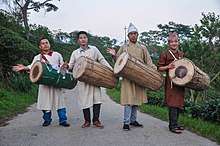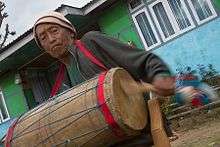Chyabrung
The Chyabrung also called Kay/Ke is a traditional drum of the Rai and Limbu community in Nepal, Sikkim, Darjeeling hills and North-East India.The Chyabrung is a hollow oblong wooden drum about a foot in diameter and two feet in length. The drum is strung around the neck with a cord at stomach height and played during auspicious celebrations and festivals of the Limbu community.[1][2]


The Chyabrung has two openings on either ends, each end being tightly stretched by goat and bull/buffalo skin: on the right and left ends respectively. The face covered by goat skin produces a sharp, treble tone whilst the face covered by bull/buffalo skin produces a flat, bass sound.
The goat skin face is called huksagay and is played with the palm of the hand the bull/buffalo side is called singsagay and played with a stick called kay chhari. The Limbus whilst playing the Chyabrung perform the Chyabrung Dance during the festivals of Kelangma and Yalakma (Dhan Naach or rice harvest dance). The only music to the dance is the rhythmic beating of the Chyabrung and dancers execute synchronized and complicated foot work depicting graceful movements of wild animals and birds.[3][4][5]
See also
References
- "च्याब्रुङ नाच" (in Nepali). Retrieved 2018-03-26.
- बाँस्कोटा, गिरिराज. "पाँचथरमा यस्तो देखियो च्याब्रुङ महोत्सव (फोटो फिचर)". Nagarik News. Retrieved 2018-03-26.
- "Sajha.com - True_Beauty_of_Nepal_JPG". Sajha. Retrieved 2018-03-15.
- "Chyabrung dance - The Himalayan Times". The Himalayan Times. 2018-02-02. Retrieved 2018-03-15.
- "Limbu community perform Chyabrung dance to celebrate Udhauli - Purbeli News". Purbeli News. Archived from the original on 2018-03-16. Retrieved 2018-03-15.